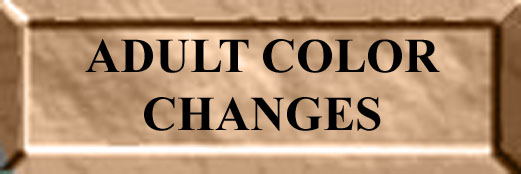 |
 |
 |
|
 |
 |
 |
 |
In many dog breeds the color of the puppy is fairly similar to the adult coloration. And most adults maintain their color unchanged throughout their adult lives. Our breed definitely contains some canine chameleons. For reasons we don't yet understand, some individuals will go through some remarkable color changes as puppies, prior to reaching their adult coloration. Color change is rarer in adults, but it does occur more frequently than previously supposed. In at least one bloodline of Aussie there is a progressive silvering of the muzzle and face that is not due to geriatric effects. Several distinct types of color change are known to occur in the breed.
Probably the most common type of color change is that of progressive darkening. Many blue merles and red merles are born with their merle areas fairly light. As the years go by they darken until in old age blue merles can resemble black tris and red merles can resemble red tris (or bis, or selfs). Not all merles darken, but it is not at all uncommon. I don't yet have a series of photos documenting this progressive change over several years, but I'll gladly use any submitted.
Another common cause of color change is found in reds and red merles. Red hair tends to sun bleach when the dog spends lots of time out in the sun. Bleaching can be quite extensive and can turn dark liver individuals to the yellowish color of broom straw. This is temporary, however, and as soon as the dead coat is shed out the dog's actual color emerges in the new growth. If sun bleaching is uneven and in patches, the dog may superficially resemble a merle even if he is a solid. For show purposes sun bleaching can be avoided by limiting the amount of time the dog spends in bright sunlight.
Another common color change involves white trim. Pups that are born with very narrow blazes and/or tiny white spots on the back tend to lose them as they mature. This phenomenon has been noted in collies and shelties as well. The reason is not known. In the case of white spots on the back at birth, the breeder should inform the buyer that they were present. That way the buyer will know to pick a mate that never had white spots. This will help avoid production of pups with white outside the prescribed areas.
Harlequins often change color as well. Harlequin puppies may be born with a number of lacy looking near white areas distributed over the body. By the time they are several months old such areas often fill in with pigment. There is a section on the Harlequin page that shows a couple of dogs going through this change.
Then we have color changes less easily explained! There are two pages, each showing a series of color changes. On the puppy color change page, we have two puppies whose color changed dramatically over the course of birth to 1 year. In Flame's case, his black tri birth coat was replaced by a silvery silvery color was again replaced by normal black by the time he was near 1 yr old. On the same page is "Red", a red puppy that as a puppy was clearly a dilute but darkened by maturity so that she does not look dilute even though she is.
The second page shows two cases of dramatic depigmentation of adult dogs. Cosmo went from a normal blue merle to a completely white dog in the space of one shedding cycle. He eventually regained some pigment but not all. Nikki was several years older when she turned white, and the change was accompanied by some changes in coat texture as well. In both cases the vets say it's ideopathic vitiligo (loss of pigment from unknown causes).
© 1999-2009 Lisa McDonald Comments